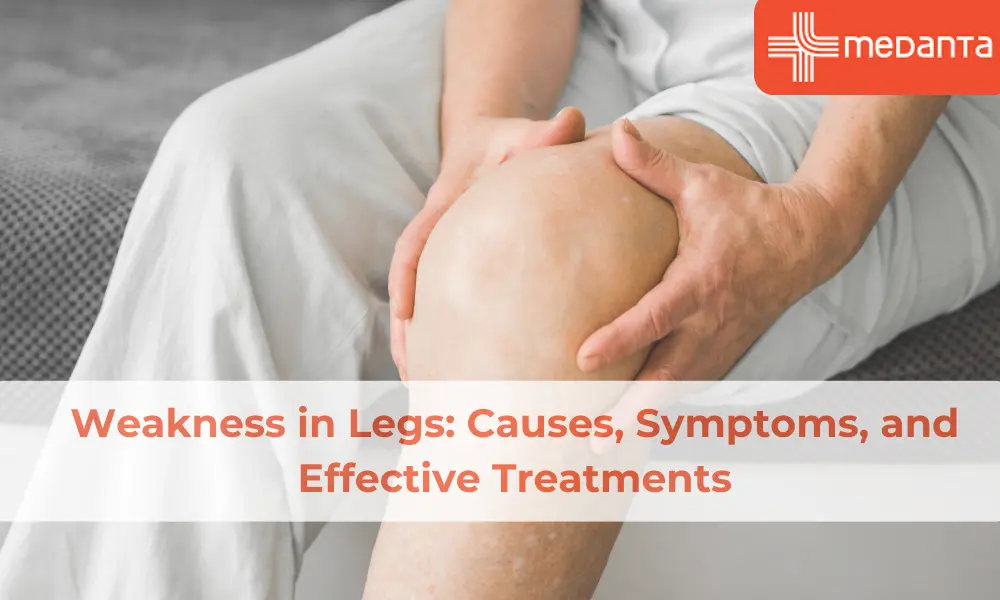Weakness in Legs: Causes, Symptoms, and Effective Treatments

TABLE OF CONTENTS
Leg weakness can strike anyone at any age. It might appear suddenly or develop gradually over time. Unlike regular tiredness, weak muscles stop legs from working properly which makes everyday tasks difficult. This condition affects thousands of people in India yearly with symptoms ranging from mild discomfort to severe mobility problems. Leg weakness can occur in one or both legs.
Recognising muscle weakness signs helps you to know when to take medical help. Several treatment options exist that manage symptoms and slow disease progression. This article helps readers find common causes of leg weakness, identify symptoms, learn about effective treatments and understand when they need immediate medical attention.
Common Causes of Weak Legs
The following are some common reasons for leg weakness:
Neurological conditions: Multiple sclerosis, Parkinson's disease, ALS
Spinal issues: Herniated discs, spinal stenosis, pinched nerves
Autoimmune disorders: Guillain-Barré syndrome, myasthenia gravis
Vascular problems: Stroke, peripheral artery disease, deep vein thrombosis
Nutritional deficiencies: Vitamin B12, vitamin D, magnesium, potassium, and iron
Metabolic issues: Diabetes causing neuropathy, thyroid disorders
Infections: West Nile virus, Lyme disease, HIV
Symptoms of Weakness in the Leg
Persistent and progressive muscle weakness stands out as the primary symptom. People might struggle to stand or walk. Their legs often feel heavy and shaky, with reduced control and frequent tripping. Some conditions cause both legs to weaken equally, while other conditions have a stronger impact on one leg compared to the other.
Medical Evaluation for Weak Legs
A detailed patient history & physical examination start the diagnosis process. Doctors examine muscle strength, reflexes, and range of motion. They might ask you to go for blood tests to check your electrolyte levels & thyroid function. Other tests that doctors may ask including but not limited to:
Nerve conduction studies
Electromyography (EMG)
MRI or CT scans
Muscle biopsy for complex cases
Home Remedies to Strengthen Leg Muscles
A 10-15 minute massage with warm olive or coconut oil twice daily boosts blood flow and eases inflammation in weak legs.
A warm bath with Epsom salt acts as an electrolyte that reduces swelling and helps control nerve signals.
Apple cider vinegar's rich mineral content including potassium & calcium, builds leg muscle strength when you mix it as a tonic with warm water.
Your vitamin D levels from sunlight or diet help curb muscle weakness, since low levels lead to weak legs.
Exercises and Physical Therapy for Weak Legs

Physical therapy is your first step to treat leg weakness. Your custom plan might include strength builders like squats & lunges, stretches and balance work.
Exercises with multiple muscle groups work best because they match real-life movements. New exercisers should start with 3-5 exercises and do 3 sets of 8-12 reps.
Lifestyle Changes to Prevent Leg Weakness
Good hydration keeps leg weakness and muscle cramps away.
Easy exercises like walking, swimming, or cycling build leg strength.
Your diet should include lean proteins, fruits, vegetables, and whole grains to give muscles the nutrients they need.
When to Seek Immediate Medical Attention
Knowing how to spot emergency signs of leg weakness can save lives. Unlike regular tiredness some warning signs just need immediate medical care.
You should get emergency care right away if leg weakness:
Comes on faster than usual
Shows up on all but one side of your body
Appears with facial drooping or slurred speech
Starts as numbness in your feet and moves up
Happens after injury to your legs or spine
Problems with balance
Not being able to move your legs, problems with balance,
The situation becomes more concerning when you have sudden & severe pain in your lower back or leg with muscle weakness.
Quick treatment makes a life saving difference for stroke patients. Medical care that starts early substantially improves your chances of recovery. Research shows that one-third of people who have a transient ischemic attack (mini-stroke) will experience a full stroke later.
Conclusion
Leg weakness affects thousands of people each year and goes beyond normal tiredness. The mechanisms behind this condition help guide proper treatment. Weak legs need proper attention and care, whether they stem from neurological conditions, spinal problems, or nutritional deficiencies.
Your life could depend on spotting signs of a medical emergency. You need immediate action if sudden weakness appears on one side with facial drooping or speech changes.
Home treatments work for many people to manage their symptoms. Milder cases often improve with simple remedies. Many treatment options exist to manage symptoms even though some conditions have no cure. Note that your body sends signals when something isn't right. Many people continue their daily activities with minimal disruption through proper care and attention to leg weakness.
FAQs
What are the main causes of weakness in the legs?
Several conditions can make your legs feel weak.
Neurological disorders like multiple sclerosis, ALS, or Parkinson's disease
Spinal problems like herniated discs, pinched nerves, or spinal stenosis.
Autoimmune diseases like myasthenia gravis
Poor circulation, vitamin deficiencies, and medication side effects can also make your legs feel weak.
How can I improve leg strength at home?
Seated knee extensions help strengthen your quadriceps - a vital exercise after knee injuries. You can do standing heel raises to make your ankles more stable. The majority of people notice better strength after doing these exercises for a month. Heel-to-toe walks help improve your balance, particularly if you're recovering from foot injuries.
When should I consult a doctor for weak legs?
You should see a doctor if your leg weakness doesn't go away, gets worse, or comes with pain, numbness, or walking difficulties. Get medical help right away if the weakness comes on suddenly, affects only one side, or happens with vision changes or slurred speech.
4. Are there specific exercises for leg weakness?
Chair squats build strength effectively - just stand in front of a chair and lower yourself without sitting completely. Try standing on one foot for 30 seconds to improve stability. Beginners should pick 3-5 exercises and do 3 sets of 8-12 repetitions.
Can diet and nutrition help improve leg strength?
Yes what you eat substantially affects your leg strength. Studies show that people who eat green leafy vegetables daily have stronger leg muscles. Your muscles need protein to stay healthy, so include eggs, wild salmon, and Greek yoghurt in your diet.
What treatments are available for leg weakness?
Doctors might recommend steroid injections to reduce swelling, physical therapy, medication to treat the root cause, or sometimes surgery. You can treat mild cases of overexertion at home with warm or cold packs.
Can leg weakness be a sign of a serious condition?
Yes. Leg weakness could point to serious problems like stroke, which happens when blood can't reach parts of your brain. It might also indicate Guillain-Barré syndrome, which starts with tingling and weakness in your feet and legs. Any sudden weakness needs immediate medical attention.





